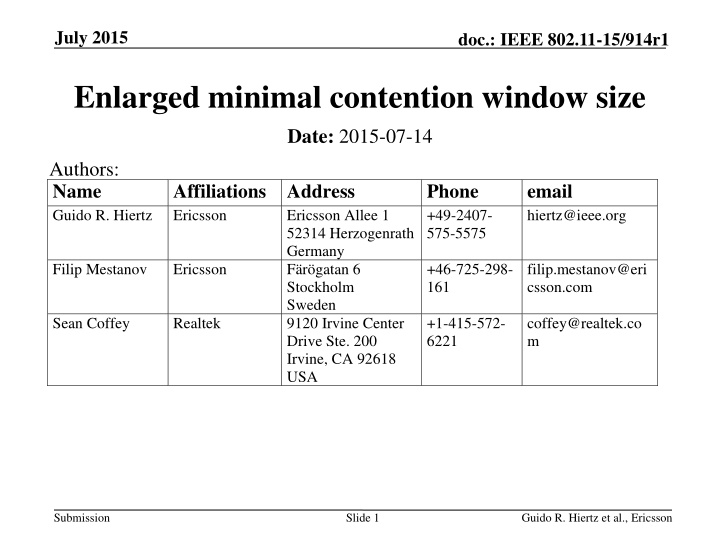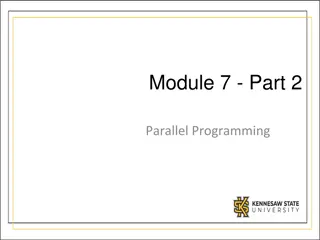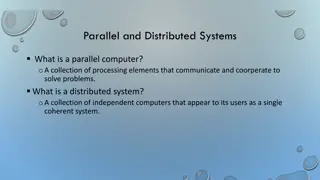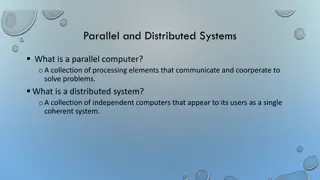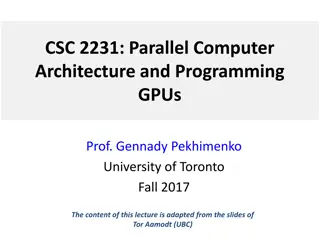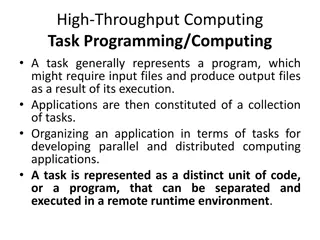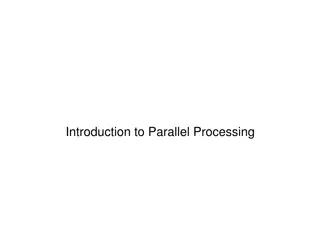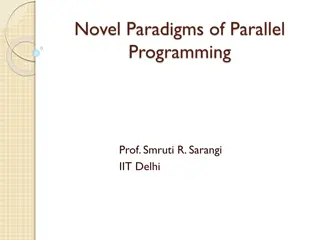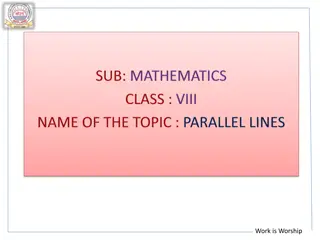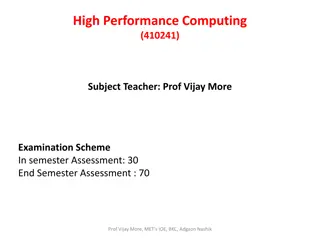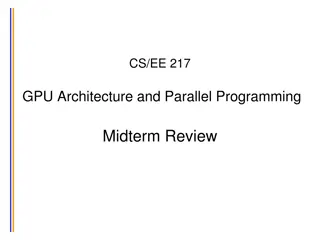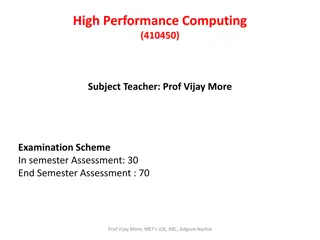Introduction to Parallel Computing Overview
Parallel computing allows for multiple computations to be carried out simultaneously, dividing large problems into smaller ones for faster processing. Learn about SMP and MPI mechanisms, specifications of the UTPA cluster, and how to utilize the UTPA High Performance Computing Cluster efficiently.
Download Presentation

Please find below an Image/Link to download the presentation.
The content on the website is provided AS IS for your information and personal use only. It may not be sold, licensed, or shared on other websites without obtaining consent from the author.If you encounter any issues during the download, it is possible that the publisher has removed the file from their server.
You are allowed to download the files provided on this website for personal or commercial use, subject to the condition that they are used lawfully. All files are the property of their respective owners.
The content on the website is provided AS IS for your information and personal use only. It may not be sold, licensed, or shared on other websites without obtaining consent from the author.
E N D
Presentation Transcript
July 2015 doc.: IEEE 802.11-15/914r1 Enlarged minimal contention window size Date: 2015-07-14 Authors: Name Guido R. Hiertz Affiliations Address Ericsson Phone +49-2407- 575-5575 email hiertz@ieee.org Ericsson Allee 1 52314 Herzogenrath Germany F r gatan 6 Stockholm Sweden 9120 Irvine Center Drive Ste. 200 Irvine, CA 92618 USA Filip Mestanov Ericsson +46-725-298- 161 filip.mestanov@eri csson.com Sean Coffey Realtek +1-415-572- 6221 coffey@realtek.co m Submission Slide 1 Guido R. Hiertz et al., Ericsson
July 2015 doc.: IEEE 802.11-15/914r1 Abstract 802.11 OFDM PHYs foresee a minimal Contention Window size of 15. With many stations contending for access to the wireless medium (WM), this initial Contention Window might be too small. A simple approach is presented that increases the number of contention slots without impacting any performance relevant aspects. Submission Slide 2 Guido R. Hiertz et al., Ericsson
July 2015 doc.: IEEE 802.11-15/914r1 Minimal Contention Window size, 2.4 GHz band 802.11-1997 DSSS & FHSS CWmin = 31 802.11b-1999 HR/DSSS CWmin = 31 802.11g-2003 Long slot time mode CWmin = 31 Short slot time mode CWmin = 15 802.11 DSSS set baseline in 2.4 GHz Most 802.11g deployments in compatibility mode Use of CWmin = 31 prevailing 802.11n-2009 uses CWmin = 15 in 2.4 GHz Submission Slide 3 Guido R. Hiertz et al., Ericsson
July 2015 doc.: IEEE 802.11-15/914r1 Minimal Contention Window size, 5 GHz band 802.11a-1999 First use of OFDM CWmin = 15 802.11n-2009 MIMO upgrade CWmin = 15 802.11ac-2013 802.11n upgrade CWmin = 15 All 802.11 standards for the 5 GHz band use CWmin = 15 Submission Slide 4 Guido R. Hiertz et al., Ericsson
July 2015 doc.: IEEE 802.11-15/914r1 802.11e Quality of Service EDCA priorities use different minimal and maximal contention window sizes Priorities adapt scaled CWmin value All 802.11n & 802.11ac STAs implement EDCA All priority values derived from CWmin Apart from AIFSN 802.11e introduces support for QoS Distributed Coordination Function (DCF) replaced by Enhanced Distributed Channel Access (EDCA) EDCA introduces four priorities Submission Slide 5 Guido R. Hiertz et al., Ericsson
July 2015 doc.: IEEE 802.11-15/914r1 CWmin design A small, initial Contention Window causes high collision probability Airtime waste, growing contention windows, high jitter, retransmissions, Compromise: Single STA (peak) performance vs. optimal performance with many STAs No One-fits-all value Submission Slide 6 Guido R. Hiertz et al., Ericsson
July 2015 doc.: IEEE 802.11-15/914r1 Dense deployments Current default values target single BSS performance EDCA parameter set adjustment seldom used Some implementations do not adopt parameters signaled by AP No influence on EDCA parameter set selection in neighboring BSSs One BSS may serve many STAs With EDCA, AP can enlarge CWmin per priority Reduces peak performance Reduces collision probability & may increase performance Submission Slide 7 Guido R. Hiertz et al., Ericsson
July 2015 doc.: IEEE 802.11-15/914r1 How to reduce collision probability? Enlarging default CWmin with 802.11ax Introduces coexistence problem PHYs prior to 802.11ax use CWmin = 15 Would decrease 802.11ax access probability compared to prior PHYs Enlarge CWmin Helps to reduce collision probability How to select optimal value? Dynamic, adaptive process needed How to signal/agree needed CWmin between different BSSs? Submission Slide 8 Guido R. Hiertz et al., Ericsson
July 2015 doc.: IEEE 802.11-15/914r1 Enlarge CWmin AND reduce aSlotTime Consider 5 GHz aSlotTime = 9 s CWmin = 15 9 s 16/2 = 72 s Select 802.11ax aSlot & CWmin to achieve mean wait duration as previous PHYs Const = aSlotTime (CWmin + 1)/2 802.11ax default set aSlotTime = 4.5 s CWmin = 31 Twice the number of contention slots compared to 802.11n & 802.11ac Mean wait duration: 4.5 s 32/2 = 72 s Submission Slide 9 Guido R. Hiertz et al., Ericsson
July 2015 doc.: IEEE 802.11-15/914r1 aSlotTime definition aSlotTime = aRxTxTurnaroundTime + aMACProcessingDelay + aAirPropagationTime + aCCATime Implementation dependent with 802.11ac aCCATime aMACProcessingDelay aRxTxTurnaroundTime Static (range dependent) aAirPropagationTime Submission Slide 10 Guido R. Hiertz et al., Ericsson
July 2015 doc.: IEEE 802.11-15/914r1 802.11ax aSlotTime = 4.5 s Assume 300 m range aAirPropagationTime = 1 s Thus today, aCCATime + aMACProcessingDelay + aRxTxTurnaroundTime 8 s To meet aSlotTime goal reduce previous sum from 8 s to 3.5 s Save 5 s to sustain 300 m range assumption aCCATime < 4 s with 802.11a-1999 aMACProcessingDelay < 2 s with 802.11a-1999 aRxTxTurnaroundTime < 2 s with 802.11a-1999 With 802.11-2012, all values are noted as implementation dependent Only values for interoperability specified anymore Submission Slide 11 Guido R. Hiertz et al., Ericsson
July 2015 doc.: IEEE 802.11-15/914r1 Feasibility study aCCATime Max time that CCA has available to detect start of a valid IEEE 802.11 transmission Major part in aSlotTime Today s hardware needs less time than previous implementations aSlotTime = 4.5 s seems possible aMACProcessingDelay Max time for MAC to issue PHY-TXSTART.request Today s hardware is more powerful than 802.11a hardware in 1999 aRxTxTurnaroundTime Max time to change from Rx to Tx Hardware evolution provides for substantially faster turnaround than in 1999 Submission Slide 12 Guido R. Hiertz et al., Ericsson
July 2015 doc.: IEEE 802.11-15/914r1 Further changes, observations With enlarged CWmin & reduced aSlotTime 802.11ax STAs achieve advantage over non- 802.11ax STAs 802.11ax STAs may access earlier Acceptable penalty on legacy STAs to be discussed AIFS = SIFS + n aSlotTime With 802.11ax double n to compensate for halved aSlotTime Keep Duration (AIFS802.11ac) = Duration (AIFS802.11ax) Submission Slide 13 Guido R. Hiertz et al., Ericsson
July 2015 doc.: IEEE 802.11-15/914r1 Conclusion aSlotTime = 4.5 s seems possible with 802.11ax Increases Contention Window, reduces collision probability Suitable with dense deployments = 802.11ax scope Halved aSlotTime gives earlier access to 802.11ax STAs Simulations to follow to show impact Can be balanced with legacy devices Simple and non- intrusive approach Submission Slide 14 Guido R. Hiertz et al., Ericsson
